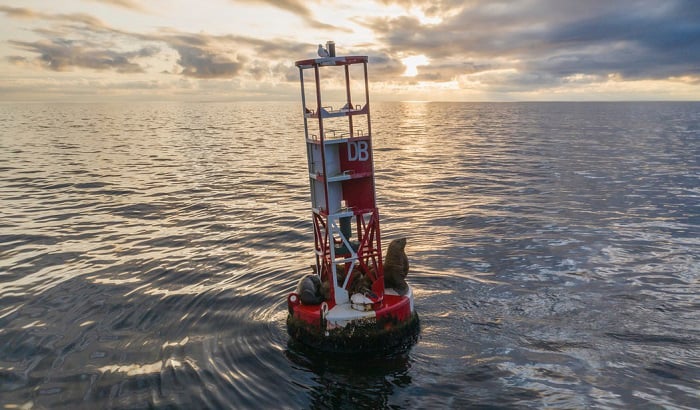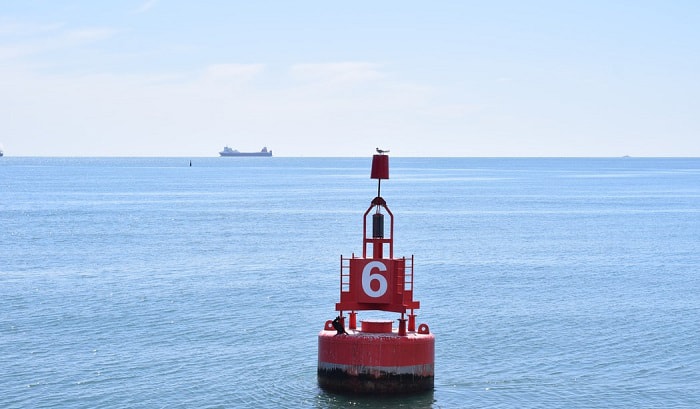Do you feel uneasy every time you take your boat out of the docks and head into open waters and vice versa? I understand your apprehension. You can soothe any angst you may have about navigating your boat in waterways if you know the answer to the query, ‘what do lateral markers indicate?’
Navigating narrow waterways signs can be a gut-wrenching experience for any first-time boat owner. You can run your boat aground or hit another watercraft if you are not careful.
That is why we will answer a few of your most nagging questions about lateral markers – the device that indicates established water routes, allowing anyone to safely navigate the waterway. Hopefully, it will make you feel more confident the next time you pilot your boat through water channels.
Table of Contents
What are Water Markers
You can think about water markers as a boater’s traffic signs that convey information or regulate movement on the water. These devices float on the water’s surfaces, complete with colors and markings for easier identification and interpretation.
For example, beacons can guide watercraft to enter the bay safely, while floats and buoys can help boat owners navigate narrow, boat-filled waterways. Some markers direct boaters to the beach or marina, while others caution them against speeding on the water.
What Lateral Markers Indicate
Lateral markers are orienting devices, giving boaters an idea of their location relative to the waterway. After all, ‘lateral’ means ‘side,’ implying that boat owners must steer their watercraft to one side of the water channel.
These floating devices indicate established water routes, allowing anyone to safely navigate the waterway without running aground or hitting other boaters.
Lateral markers also help keep track of one’s bearings. If you have ever flown in an airplane before, you know that it would be challenging to know where you are in the vast sky.
The same thing happens on the water. It would be impossible to establish your general direction without lateral markers to guide you.
These navigational aids also help you determine if you are drawing closer to the open sea or moving farther away from it.
What are the Different Types of Lateral Markers
Two types of lateral markers are hassle-free to identify and interpret, indicating the side of the waterway you must steer your boat. However, there is another lateral marker that signifies the splitting of a water channel into two waterways.
1. Starboard-Hand Markers
Starboard-hand lateral markers are objects you see on the starboard (right) side of the waterway when heading upstream or inland and away from open waters.
It is similar to ordinary roads or streets where you always drive on the right lane relative to where you are heading.
As for piloting boats on waterways, the reference direction is always upstream or heading inland and away from open bodies of water. The waterway’s right side is always the starboard hand.
Starboard-hand lateral markers always have a red color. To make it easier to remember, ‘red’ is always for ‘returning’ to port.
Red markers also have even numbers printed on their bodies. These numbers indicate the distance of the marker from the open sea. You will notice that the farther inland you go, the greater is the value of the number.
Authorities always place starboard-hand lateral markers together with port-and devices in water channels. It is like a two-lane road where vehicles drive on their respective sides, depending on their direction.
Hence, if you see both markers in the water, it would be best to pass between them.
2. Port-Hand Markers
As mentioned, port-hand lateral markers always work in tandem with starboard-hand markers, allowing boaters to pass between them safely.
If a red buoy marks the right side of a water channel going inland, a green buoy works the opposite lane.
In other words, green markers tell boaters they should stick to the right side of the waterway when heading back into the open waters.
Starboard-hand lateral markers also have odd numbers printed on them. The numbers decrease in value as you draw closer to the sea.
3. Bifurcation Markers
You may also notice markers with both green and red colors. These navigational aids indicate the waterway will split into two separate water channels.
As a rule, you must always steer your boat to the channel indicated by the top color. So, if you see a red-on-green marker, you will want to stay on the starboard-hand side (right side if heading upstream).
Kinds of Markers Every Boater Must Know
Lateral markers come in different forms. Your knowledge of these designs can help you navigate your boat through the waterway more confidently and safely.
1. Buoys
These markers float on the water’s surface, held in place by an anchor or some similar structure. Lateral buoys can be either cans or nuns.
Can buoys have a green color, cylindrical body, and a flat top. They derive their name from the ordinary tin cans we buy from the grocery.
Nun buoys also have a cylindrical body but with a cone-shaped top. This unique design makes them look like ‘nuns’ from a convent. Nun buoys are always red, denoting their classification as starboard-hand markers.
2. Beacons
Unlike buoys that float, beacons are tall fixed structures. An excellent example of a beacon is a lighthouse.
One distinguishing characteristic of beacons is flashing lights, allowing you and other boaters to determine your way in the dark sea.
However, some beacons also have green or red signs or marks on them.
3. Daymarks
These lateral markers are similar to your regular signposts. Red daymarks always have a triangular shape, while green daymarks are square.
As the name implies, daymarks are navigational aids suitable for daytime use. While they may have flashing lights, daymarks are not easy to spot at night, especially in stormy weather.
Conclusion
What do lateral markers indicate? These navigational aids let you determine your position in the waterway, allowing you to navigate your boat safely. The markers include buoys, beacons, and daymarks.
Lateral markers also come in green or red colors that indicate port-hand and starboard-hand passage, respectively.
This information should make your boating safer, more enjoyable, and less confusing.

I am passionate about water sports and technical fields, so combining both makes me interested in making contents about boat accessories. With my partner, we went on many trips and sports games together, which led us to think about how we can spread our joys and passions to many people.



